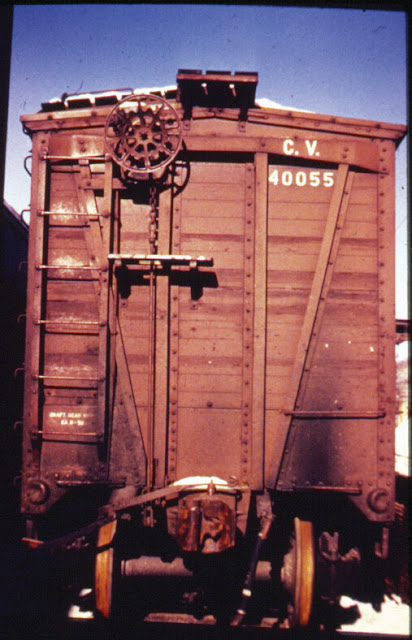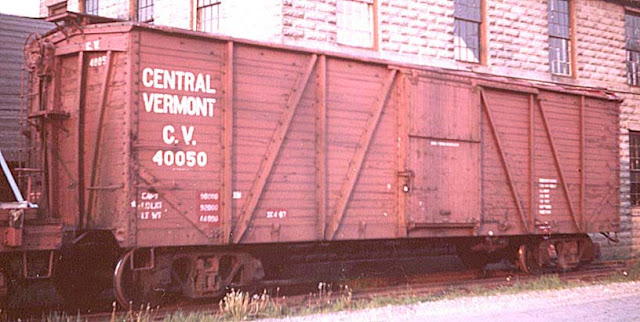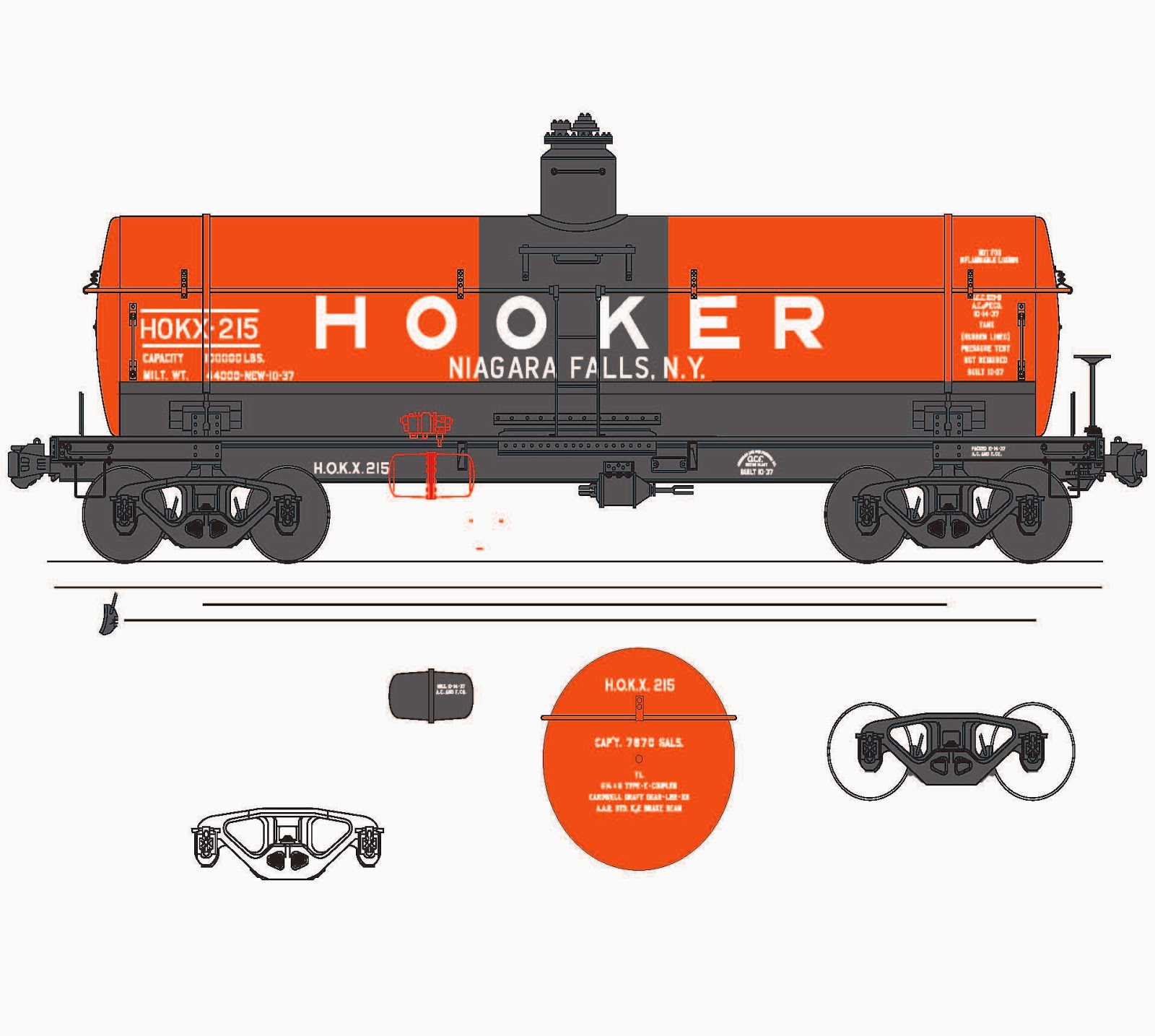 |
| A comparison of Rutland PS-1 #100, as built and #194, with all updates completed. |
Reprinted with permission of the Rutland Railroad Historical Society and authors Phillip Blancher & Kevin Pytlak. Article published in Winter 2014 (Volume 25, Number 4) issue of the Rutland Railroad Historical Society magazine, "The Newsliner."
By Phillip Blancher & Kevin Pytlak
All Photos by Phillip Blancher
Pullman Standard's PS-1 box Car is THE iconic piece of rolling stock that defined the vision Rutland Railway president Gardiner Caverly laid out for the railroad in the early 1950's, that of a modern, streamlined, service-oriented gateway that would rapidly move shippers products to market. If you are a model railroader modelling the Rutland in the 1950's or early 1960's, a fleet of these cars is a must.
In the last 15 years, HO-scale modellers have been fortunate to have had two manufacturers release PS-1’s, and in 28 car numbers. Kadee's well-detailed model is presently available in four road numbers while Intermountain Railway Company has produced 24 different numbers under their own brand as well as for The Express Station and The Steam Shack. The Intermountain models have been updated along the way, meaning that there is some variation in the amount of detail on production runs. The Steam Shack's later releases included etched roof walks and improved paint and graphics. Updating the detail fidelity of the earlier Intermountain releases is not a difficult operation and can be done in stages.
The first task for us was to consult any and all photos that could be found among the many sources available: books, issues of The Newsliner, and the Internet. Required information that could not be easily tracked down ended up as questions placed on the Steam Freight Car email list hosted on YahooGroups. Once sufficient information was gathered, a shopping list of items required to update the various PS-1 models was drawn up.
 |
| As an-built photo of the original kit, purchased used from a seller on Ebay. |
Many of the earlier cars were purchased on the E-Bay auction website or on the YahooGroups HO Interchange email list. Some of the cars were purchased as un-assembled kits, but others were ready-to-run. This article will deal only with updates and changes to the fidelity of the car, and will not cover any repairs that had to be made to a previous owner's work.
Beginning with the wheels and working up from there, the trucks will need to be changed out. The Rutland PS-1's came with solid bearing, ASF A3 Ride Control trucks. These can be replicated with Kato part 31-601 which have excellent detail including brake beams. That said, the wheel sets were replaced with Intermountain Code-88 semi-scale wheel sets. In the interval that has passed since the parts were purchased for this project, Tahoe Model Works has released their own version of the ASF A3 trucks. They can be purchased with Intermountain semi-scale wheel sets, part number TMW-110/210. The detail level of these trucks is just as good as the Kato trucks and may be more readily available.
Continuing on to the brake rigging, the plastic pieces are easily broken when removing parts from the sprues. Where the lines could not be glued into place, new lines were bent from 0.015 brass wire. The angle cock, glad hand, and air line for each end of the car was replaced with Cal-Scale parts. The coupler boxes were drilled and tapped for 2-56 screws and Kadee #158 Whisker Couplers were installed in them. The trip pins were removed.
Moving on to the car sides, the doors and ladders were installed as per instructions. End grab irons were replaced with wire pieces formed from phosphor bronze wire from Tichy Train Group.
 |
B-End details include etched
brake wheel platform, and brake wheel. |
On the B-end of the car, the brake wheel was replaced. For cars 100-107, the Ajax brake wheel was used (Kadee Part number) while for cars 108-450, the Universal brake wheel was used (Kadee Part number). The brackets for the brake wheel platform were installed, but the plastic walkway material was not used. Detail Associates coupler lift bars were added using an eye bolt in the left corner and one attached to the coupler box. The lift bar is secured to the left corner of the car but only looped into the eye bolt on the coupler box. This makes access to the coupler box simpler should servicing be required.
 |
Modifications to the A-end include
Kadee #158 couplers, grab irons,
and uncoupling levers. |
The “Style-A” plastic stirrup steps under the side grab irons were replaced with bronze parts formed from A-Line. The stirrup under the ladder could be replaced with a “Style-B” brass part as well.
Instead of using NMRA practices to weight the car, pennies were used. A penny weighs 1/10th of an ounce, therefore 15 to 20 pennies, centred along the middle of the floor inside the box car body, were glued in place. The doors were also attached at this time, followed by the roof. Elastic bands were used to hold the roof in place while the glue set.
 |
| The Plano etched roof walk really makes this roof pop. The authors are members of the famed Yellow Roof Society so the roof walks were painted to match the roof. |
A Plano Model Products #191 40' Apex Walkway set was installed as per that company's instructions, the parts having been painted before installation. To attach dissimilar materials such as metal to plastic, a thin bead of Canopy Glue was applied with a Microbrush. The Canopy Glue works well in this application because it dries clear and is flexible enough to allow for the different expansion/contraction rates of the materials. This helps prevent the walkways from popping off the model.
Other than touch-up and painting the roof walk, no other painting is required. The roof walk was painted yellow to match the yellow of the roof. Badger Modelflex primer grey was applied first, followed by C&NW Yellow from the same brand. The truck frames were painted with Oily Black paint and the wheels with Burnt Umber mixed with Black on the wheel faces and wheel backs. This treatment helps suggest oil, dirt and grime from the solid bearing trucks.
Updating the lettering to bring the cars up to the same level as the later Steam Shack releases was accomplished with decals from Train Detail Works by Jerry Glow. Two decals sets were released by TDW that cover all lettering for trust plate lettering, markings, and numbering. The first set covers the 150-299 series, while the second set augments the first with numbering and details for the 100-149 and the 300-450 series.
One detail that is often ignored is car re-weigh markings. Since 1959 is the year being modelled, it means that lower-numbered PS-1's would have been re-weighed and should be re-marked accordingly. Most of the re-weights were done at the car shops in Rutland, but it would not have been unusual for them to have been re-weighed at Bellows Falls, Alburgh or Malone. With re-weighs, try to refer to photos of the prototype.
Once the decals were finished, a thin coat of Testors Glosscote was airbrushed over the car to seal the decals and to also cover any decal film residual that might still show. Modellers will often choose to Dullcote directly over the decals following their application but this can actually make the decal film stand out. Once the Glosscote has dried, a light application of Dullcote was made. Next it was time to get dirty with car weathering.
Using a combination of artist oils, washes and some acrylic dry-brushing to weather the roof, sides and ends of the car, the first task was to airbrush the underside of the car with thin coats of Badger Modelflex Dust, Dirt and Grime paints. Working from darkest to lightest, weathering was concentrated near the trucks. The trucks themselves and the wheel sets were weathered using poster stencil cream available from Michaels.
 |
| Completed PS-1s #194 and #118 show off their worn paint before going into service. |
For cars in the lower number series, some rust spots were added to the sides of the car in appropriate places, such as where the door may have banged into the side of the car when being opened. On the roof, extra rust was applied to areas where water would pool and collect, such as near the seams and ribs. Always work from photographs and use oil paints for the rust because they have a slow drying time and are easy to wipe off if the results are not what is desired. A thin layer of Dullcote will dry the oils very quickly. A final coat of Dullcote was added to seal the weathering is applied once everything is satisfactory.
With that the car is ready to be released from the shops and head back to revenue service on the layout.
About the Authors:
Phillip Blancher is Membership Chair of the Rutland Railroad Historical Society and the resident web-geek for the RRHS web site. The father of four kids is a communications and marketing consultant for the newspaper industry and as a web developer. Based in Morrisburg, Ontario, Blancher models the Rutland circa 1959 centred around Malone, New York.
Kevin Pytlak is the former owner of The Happy Hobo in Tampa, Florida and a confirmed freight car nut. Father of one, Pytlak works for an IT-company in Tampa and moonlights as a drummer in a Christian rock band. His interests are primarily Seaboard Coast Line between 1967 and 1975.
Parts List:
Kato 31-601
Solid Bearing, ASF A3 Ride Control truck
or
Tahoe Model Works 110/210 - Solid Bearing, ASF A3 Ride Control truck
A-Line
29000 – Style-A Stirrup Steps
29001 – Style-B Stirrup Steps
Cal-Scale
190-276 – Air Hoses & Bracket
Detail Associates
229-2222 – HO Eye Bolt 3 1/2' dia long
229-6215 – Freight Car Coupler Lift Bar
Intermountain
IRC40052 – 33'' Semi-Scale Brass Insulated Wheel Sets
Kadee
58 – Semi-Scale Whisker Coupler
2040 – Ajax Brake Wheel (Black)
2043 – Universal Brake Wheel (Black)
Plano Model Products
191 – 40-foot Apex Walkway
Tichy
1106 – 0.012" Phosphor Bronze Wire
1102 – 0.015" Phosphor Bronze Wire
Rutland PS-1 150-299 Decal Set
Rutland PS-1 Supplemental Decal Set

































